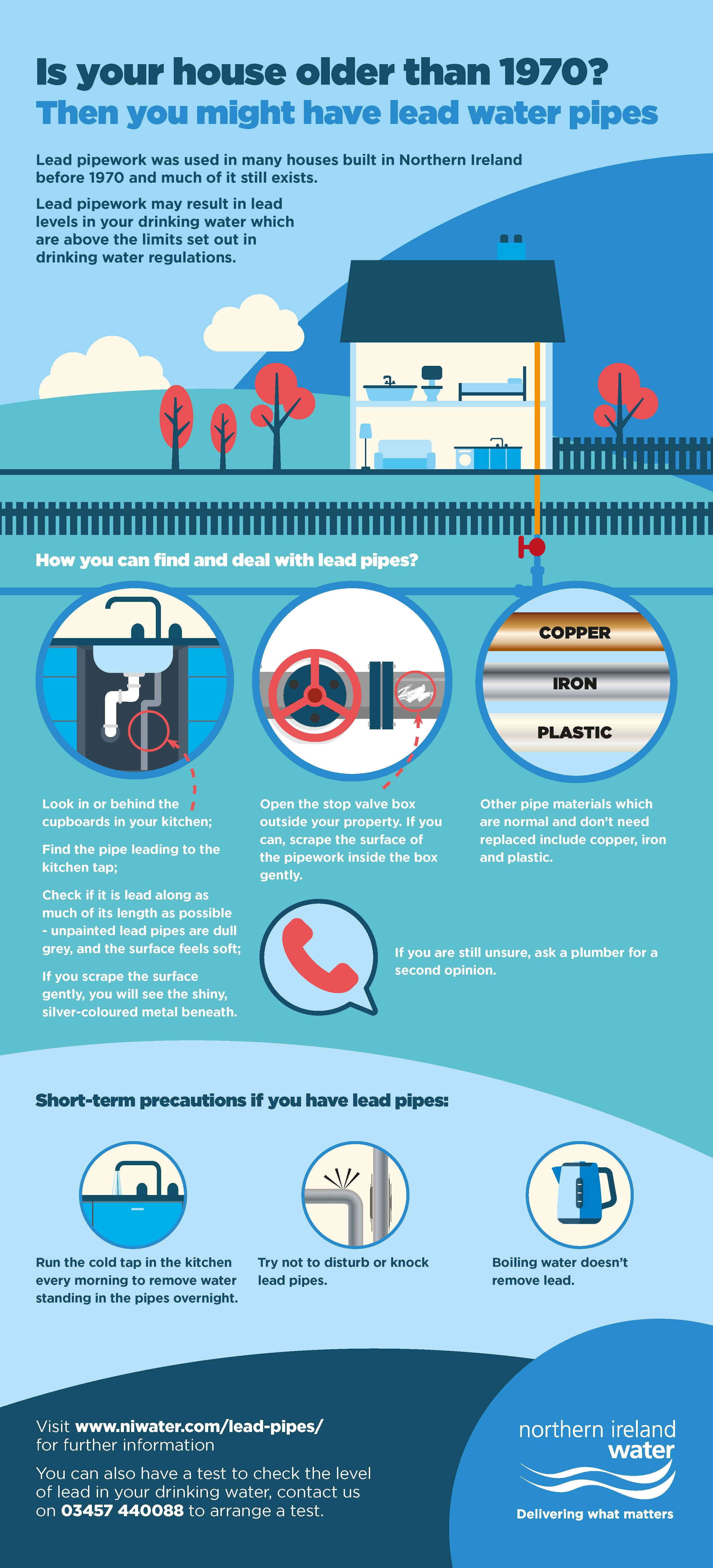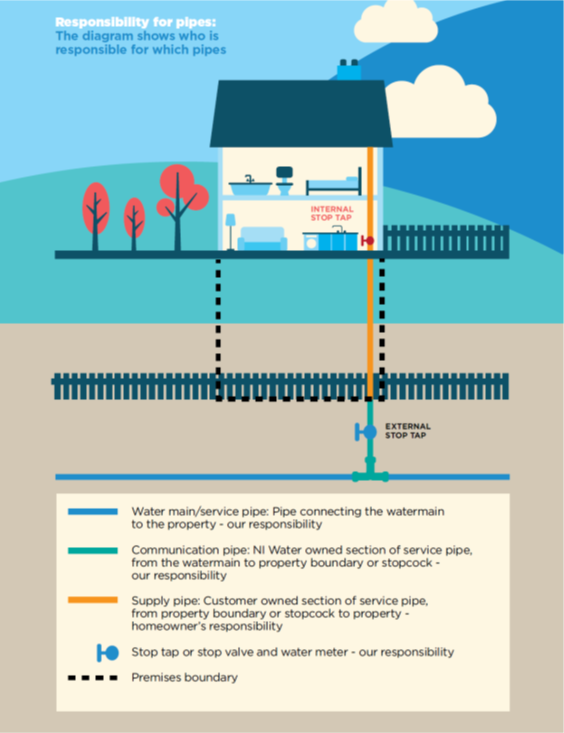
Lead in Drinking Water and Lead Pipes
Lead occurs naturally in our environment and can be present in air, food, water and soil.
Lead has long been recognised as being harmful, especially for unborn babies and young children, so various measures have been introduced to reduce everyone’s exposure to it.
Worldwide it is recommended that human exposure is kept to a minimum and therefore controlled in air, soil, food and water. For instance, lead has been reduced in paint and petrol.
Our aim is to contribute to public health by improving drinking water quality. This leaflet explains what NI Water is doing to reduce lead levels in our drinking water. The regulatory limit for lead in drinking water is 10 micrograms per litre (European Drinking Water Directive). This standard applies to cold water drawn from the tap used for normal drinking water purposes.
Water leaving our treatment works and travelling through the water mains contains only tiny traces of lead. If lead is present in a customer’s drinking water, almost all of it will have been dissolved from lead pipes and fittings between the mains and the customer’s tap.
Whilst most of this pipework is the customer’s responsibility, we must, by law, treat the water supply so it dissolves as little lead as possible. A less common cause of lead in drinking water is the illegal use of lead based solder to join together sections of copper pipe. Lead solder is still sold for use on closed central heating systems and mistakes occasionally happen whereby unqualified plumbers or householders use lead solder on drinking water pipes contrary to the law. For all these reasons, the amount of lead in drinking water at a particular property may sometimes be above the health based standard.
Questions and Answers
How do I know if there are lead pipes in my house?
If your home was built before 1970, there is a chance it will have lead pipes. If your home was built after 1970 or has been modernised since 1970 and all the pipework has been replaced between the NI Water stop valve outside your home and the kitchen tap, there should be no lead in your property. It is also possible that you have lead pipes linking your home to our water network.
If you are unsure, you can make the following simple checks:
-
Inside your home
- Look in or behind the cupboards in your kitchen. You may also need to look in other places, such as the cupboard under the stairs.
- Find the pipe leading to the kitchen tap.
- Check if it is lead along as much of its length as possible. Unpainted lead pipes are dull grey, and the surface feels soft. If you scrape the surface gently with a kitchen knife, you will see the shiny, silver-coloured metal beneath.
-
Outside your home
Open the flap of the stop valve outside your property. Examine the pipe leading from the stop valve to your property. If you can, scrape its surface gently with a knife. (In some cases it may be out of reach.)
Other pipe materials in common use are:
- Copper – bright, hard and dull brown
- Iron – dark, very hard and may be rusty
- Plastic – may be grey, black or blue.
What can I do to reduce the lead levels in my water?
If you have lead pipes between the stop valve outside your home and your kitchen tap, the best solution is to replace it with copper or plastic pipes. If you are planning on replacing your pipework, we recommend that you employ a qualified plumber to carry out any plumbing work, for example one who is accredited through the WaterSafe scheme. Refer to the WaterSafe website and see also our website – Find an Approved plumber Find an approved plumber (niwater.com)
If you do replace your part of the service pipe, you can ask us to replace our part between the water main and the boundary of your property. We will do this free of charge.
Make sure that the removal of lead pipes does not reduce electrical safety – if your electrical supply is earthed to your pipes, it will need to be earthed by another method. If in doubt, ask an approved electrical contractor.
You can also take some simple short-term precautions to reduce the risk of lead in your drinking water:
- Only use the cold tap water for drinking or cooking. Hot tap water will dissolve more lead than cold water.
- Do not drink water that has been standing in the pipes for long periods, overnight or for several hours while no one has been at home. In these circumstances, clear the water that has been standing in the pipes by flushing a toilet or filling a bowl from the kitchen cold water tap. (If you have more than 40 metres (132 feet) of lead pipe, you will need to run more than a bowlful of water.) Don’t waste that water – use it on the garden or for something else other than drinking or cooking. You can then use the water from the cold kitchen tap as usual for drinking and cooking purposes.
- Check that any hot water pipe which runs alongside or across a cold water pipe is properly insulated to prevent the cold water pipe from heating as this will increase the risk of lead dissolving into the water supply.
When having plumbing work carried out on your drinking water system in your property, check that lead free solder is used. Lead solder is still permitted for use in closed central heating systems and mistakes occasionally happen whereby unqualified plumbers or householders use lead solder on drinking water pipes.
Can I measure the amount of lead in my water?
If you are concerned that you may have lead pipework, or would like your drinking water checked for lead, please contact us to request a lead sample to be taken at your property and we will send a sampler out to take a drinking water sample for analysis, free of charge. To arrange this, please contact 03457 440088.
Following testing of the sample we inform you, in writing, if lead concentrations are higher than 10 micrograms per litre and we will investigate further. Following our investigation, if we find that there is lead pipework connecting your property to the water main (communication pipe – NI Water responsibility) we will replace this section of lead pipework free of charge. It will be up to you (or your landlord if you do not own the property) to decide whether to replace any lead pipework on your property (supply pipe – homeowners responsibility). You (or your landlord) will be responsible for paying to replace these pipes.
What is Northern Ireland Water doing to reduce lead in my drinking water?
Our aim is to deliver water, which meets the lead standard and regulations, whilst working towards a lead free water supply.
We tackle the problem in two ways:
By chemical treatment to reduce the amount of lead that dissolves from lead pipes into the water and the replacement of lead communication pipes that connect customer properties to the watermain in our distribution network.
1. Chemical Treatment
In many parts of the UK, including Northern Ireland, orthophosphoric acid is used to prevent lead dissolving into the water supply. Orthophosphoric treatment is a standard treatment method used by the water industry around the world and does not produce any harmful effects. The use of orthophosphoric acid for drinking water treatment is approved by the Drinking Water Inspectorate.
Orthophosphoric acid is a common additive in many soft drinks at concentrations up to 100 times higher than that used in the treatment of drinking water.
Will I notice any effects in my water supply?
You may have noticed some slight changes in the coating left on the inside of your kettle, but orthophosphoric acid will not change the taste, colour or odour of your drinking water.
What will orthophosphoric acid do to my tropical fish?
At such low levels, nothing.
I have replaced my lead pipes. Can I opt out of chemically treated water?
No. We apply the chemical at the treatment plant that services your mains water supply.
Does orthophosphoric acid do any damage to the environment?
The introduction of orthophosphoric acid to drinking water will add to the overall levels of phosphates in the environment. Northern Ireland Water have set a maximum dose rate to ensure treatment to reduce lead in drinking water is effective and that phosphate levels are kept as low as possible.
High levels of phosphates can increase algae growth in lakes and estuaries. Algae use up oxygen and reduce light in the water: this can affect the health and diversity of fish and plant life. Our larger wastewater treatment works have treatment stages, which reduce the levels of phosphate being discharged to the environment.
2. Replacement of Lead Pipes
Properties are typically supplied through a service pipe which consists of a supply pipe (customer’s responsibility) and the communication pipe (NI Water’s responsibility). The division of responsibility for the service pipe between NI Water and property owners is as shown below:
- Service Pipe: Pipe connecting the watermain to the property;
- Communication Pipe: NI Water owned section of service pipe, from the watermain to property boundary or stopcock;
- Supply Pipe: Customer owned section of service pipe, from property boundary or stopcock to property.

NI Water have a programme to identify and replace lead pipes within its infrastructure. As part of this programme customers are informed when lead communication pipes have been replaced and are encouraged to replace their lead supply pipework We are actively replacing lead communication pipes in the following ways
- as part of our proactive programme of work to remove lead pipe from within our infrastructure,
- when we are laying a new water main
- if lead above the regulatory limit is detected in a water sample taken at the property.
We also replace lead communication pipes at the request of a customer when the customer (or property owner) replaces their part of the service pipe, providing it is also made of lead. Complete the application form for lead pipe replacement and attach it to your request at self-service.
When we replace or carry out work on the lead communication pipe to your property there is a potential for a short-term elevated level of lead in the water due to disturbance of the lead pipe. Following restoration of the water supply to your property we recommend that you run your cold-water kitchen tap for at least ten minutes before using the water again. Over the next three days you should also run the tap for two minutes after not using it for a while, such as overnight.
Contact us:
Waterline 03457 440088
Report leaks on roads and footpaths to Leakline: 08000 282011
Text phone 0800 0515446
email: waterline[AT]niwater[DOT]com